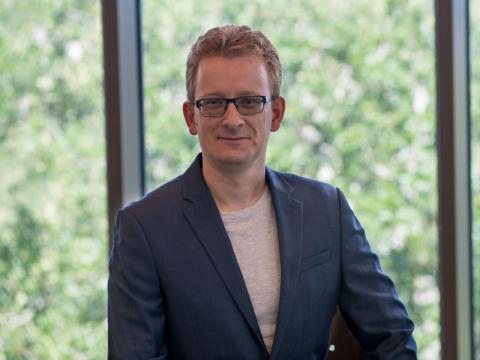Denys Bondar, Ph.D.
Associate Professor

Mailing Address
Department of Physics & Engineering Physics
2001 Percival Stern
Tulane University
New Orleans, LA 70118
Education & Affiliations
Biography
Prof. Bondar conducts theoretical and computational research at the boundary of quantum technology and ultrafast nonlinear optics. Of particular interest is the exploration how quantum control can be used to produce on-demand nonlinear optical properties, and how tailored nonlinear optical effects can enhance information processing tasks. The research of the Bondar group was recently featured in Quantamagazine, Nature Materials, Physics, PhysicsWorld, US Army, Finding Genius Podcast, Tulane News etc.
Prof. Bondar joined the Department of Physics and Engineering Physics, Tulane University in 2018. Previously, he had been an Associate Research Scholar and Lecturer at Princeton University since 2014. He was promoted from a postdoctoral appointment at the Department of Chemistry, Princeton University. He earned his Ph.D. in Physics from the University of Waterloo, Canada in 2011 and M.Sc. with Honors from Uzhhorod National University, Ukraine in 2006.
Awards
- W. M. Keck Foundation Award (2021)
- James MacLaren Early Career Professorship in Physics (2021)
- Young Faculty Award DARPA (2019)
- Humboldt Research Fellowship for Experienced Researchers (2017)
- Air Force Young Investigator Research Program (2016)
- Los Alamos Director’s Fellowship (declined) (2013)
- President’s Graduate Scholarship (University of Waterloo) (2010)
- Ontario Graduate Scholarship (2010)
Recent Publications
Interests
- Quantum technology
- Optics including quantum, ultrafast, nonlinear, and incoherent
- Optical communication and sensing
- Nonequilibrium quantum statistical mechanics
- Many-body quantum physics
- Quantum-classical analogies
- Quantum-classical hybrids
- Tunneling of complex systems (BEC)
- Superoscilations
Brief Research Summary
- High performance computing via nonlinear optics: The dominant paradigm of solid-state digital computers is bound to reach the technological limits with no viable alternative in sight. Thus, it is time to seek novel physical realizations of computing. We evaluate the possibility of utilizing nonlinear optical effects as a computational platform. This may pave the way for the development of new physical realization of computation.
- Quantum reservoir engineering: Realistic models of large quantum systems must include dissipative interactions with an environment, which may be of various natures (e.g., spontaneous emission, fluorescence, collisions, etc). It is widely believed that the dissipative forces destroy quantum features. This opinion is being challenged by reservoir engineering. In particular, it is possible to preserve and even enhance the quantum dynamical features of a system by judiciously coupling the system to a dissipative environment. Moreover, dissipative dynamics opens unique possibilities, not offered by potential forces, such as the violation of Newton’s third law.
- Novel optical technology exploring quantum-classical analogies: Optical analogs of quantum phenomena rely upon the resemblance of the Schrodinger equation to the wave equation with the paraxial approximation, where the wavefunction is replaced by the electric field. Using this analogy, we are developing new optical technologies for sensing and communication by adapting quantum reservoir engineering to the realm of classical optics.
- Quantum-classical hybrids: The interplay between quantum and classical systems is one of the most fascinating open questions of modern science. In particular, classical-quantum hybrid systems, in which both quantum and classical degrees of freedom interact, lies at the heart of several scientific disciplines ranging from chemistry to quantum gravity. Despite its importance, a fully consistent classical-quantum theory has eluded the countless attempts to develop one. In order to describe the hybrid systems, we are utilizing the Koopman-von Neumann (KvN) theory, which provides a quantum-like description of classical mechanics in terms of wave functions and self-adjoint operators. The KvN approach is based on a fundamental observation: both classical and quantum evolutions are represented by unitary transformations. Although widely used in dynamical system theory, the KvN method remains unknown in other areas. The KvN approach is diametrically opposite to the phase-space representation of dynamics, which has been the basis of all the previous attempts to construct hybrid systems, providing a classical-like description of quantum dynamics in terms of momenta and coordinates.
- Theory of theories: We are living in the age of omnipresent data. A much-needed capability is to convert the collected data, irrespective of its nature, into knowledge characterizing the phenomenon that generated the data. This is a bottom-up approach, when a dynamical model is inferred from observed data. Whereas, the top-to-bottom approach refers to when a model is proposed first and then its predictions are confronted with observations (e.g., the least action principle). We are developing the bottom-up framework of Operational Dynamical Modeling that will allow physical models to be distilled directly from measured data in a systematic way. This approach will not only enable to obtain efficient models for complex systems, but also solve open problems in nonequilibrium quantum dynamics.
- Superoscilations: If over a brief time interval, we combine several light waves of different wavelengths into an almost perfect destructive interference, the combined electric field does not become exactly zero. Instead, the field performs weak and rapid oscillations, the superoscillation, that is faster (with a seemingly shorter wavelength) than the original light waves that are combined. We experimentally and theoretical develop the applications of this phenomena to enhance optical sensing.
Courses
ENGP/PHYS 3660 Intro to Feedback Control
PHYS 3170/6170 Computational Physics and Engineering
PHYS 3630 Electromagnetic Theory
PHYS 3910/7310 Numerical Dynamics Simulations
PHYS 4470 Introduction to Quantum Mechanics
PHYS 7130 Solid State Physics
PHYS 7230 Electromagnetic Theory I
